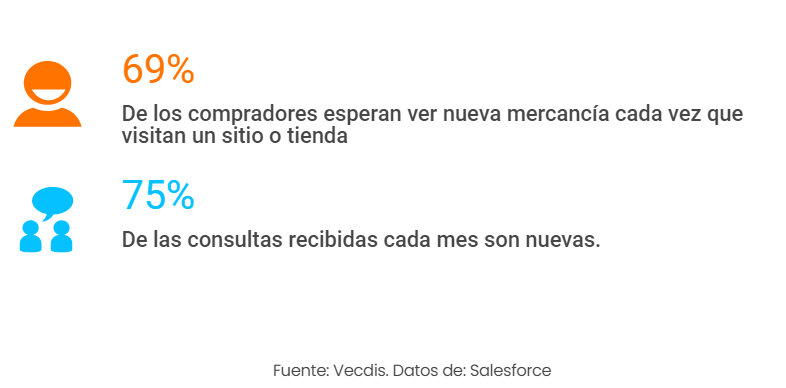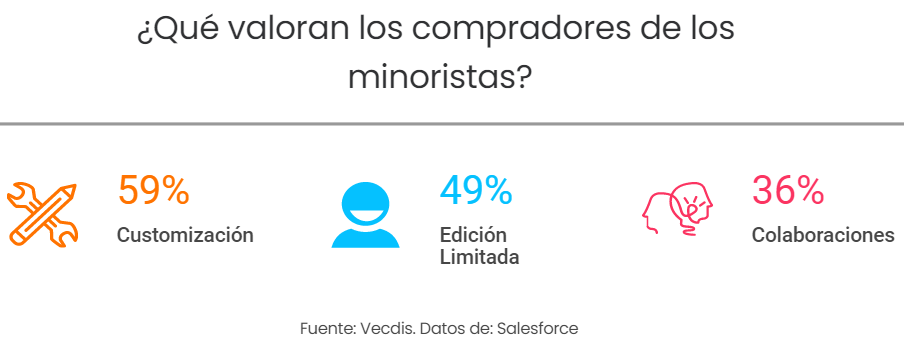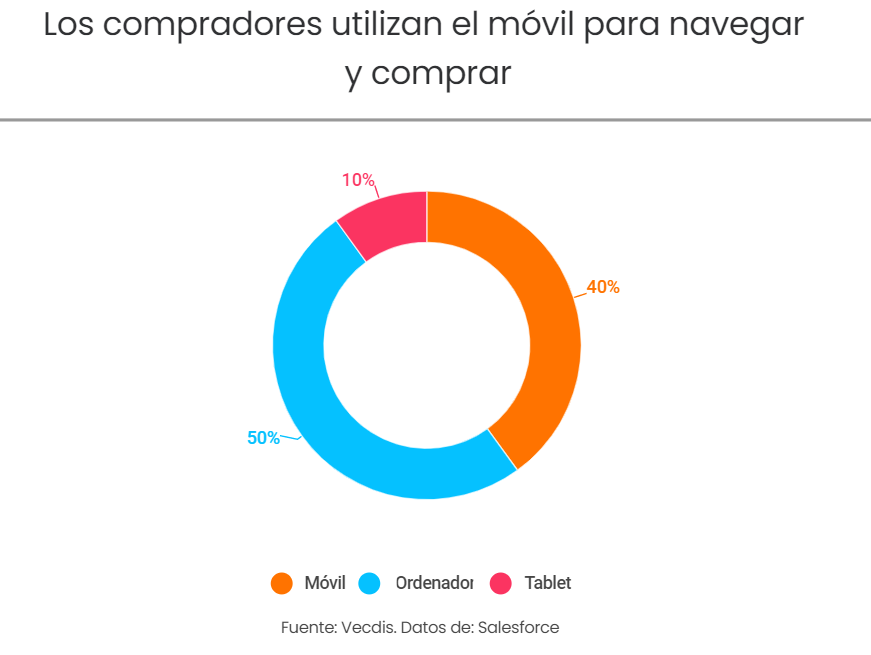More than 87% of customers go to an online store first

Retailers are at a point where they should put aside what they believe in and focus on what their customers need. It’s important to identify where and how consumers interact, where they experience the most friction, and what their behavior means for the retail industry.
Trends affect all retailers or brands, regardless of the size of the company, so it can be said that consumer choice increasingly determines the retail landscape.
A study conducted by Salesforce, based on surveys conducted from more than 6,000 consumers and the analysis of more than 500 million online movements in Salesforce’s Commerce Cloud platform, highlights the top three mandates that the new consumers demand from their retailers.
Updated offer
Consumers continually demand innovative, innovative and personalized products. They reward innovation by increasing their purchases and that can be seen by reviewing which products have been sold each month, as the top 59% of the top 5% of the products sold are new.
This creates a precedent for retailers, who 32% of the products must be renewed monthly. Consumers expect to see new products every time they make a purchase, leading brands to shorten their product development cycles and emphasize speed and agility, with the aim of increasing the number of consumers.
Marketing agility is a brand’s ability to quickly launch a product and increase its turnover. However, it is not a question of producing fast fashion products or disposable products, but of transforming consumers’ online experiences into a cost-effective action.

Each stage of the customer experience will benefit retailers if sales have a fast and novelapproach.
An example of how to carry out this approach is the fashion brand Uniqlo, which has allocated a part of its stores both physically and online, only to products that constantly vary throughout the season.
In addition, collaborative collections from brands such as MOMA, Marvel and Disney help the fashion company maintain a high speed of product creation.
Thisapproach, “alwaysactive and alwaysnew”, captures the attention of more frequent consumers, who know that they will always be able to count on the brand to show them something different on each visit.
According to the salesforce survey,more than 50% consumers would repeat in the same trade within 16 days of their firstpurchase. Therefore, to protect themselves from customer wear and tear, brand leaders must prioritize new re-engagement strategies, whether through rapid marketing reorientation, personalized loyalty offerings, or instant sales opportunity perfectly synchronized.
Online sales win
For today’s consumer, easy access to unlimited products is just a click away. Amazon alone sells more than 3 billion products in 11 markets, highlighting the difficulty it poses for retailers to compete on a variety of products.
Instead, retail professionals should target differentiation, product creation, and experiences that appeal to customers’ desire to find an offer that matches their values and interests.
Agility, loyalty and personalization are imperative for retailers and brands to differentiate theself and win a second purchase. Unforgettable experiences and products cannot be turned into commodities.

Focus on the customer
Consumers reward brands that anticipate and also identify their needs. Today’s consumers are more connected than ever, meaning they change purchases of purchases and devices continuously, while they expect retailers to recognize them and offer them a satisfying shopping experience.
To do this, retailers must guide their customers and offer them the best omnichannel experience on the market.

The 87% of the customers start searchingfor their products in an online environment, and of them 71% confirms that they use their mobile devices in stores, both to search for products, to compare prices or consult reviews.
Parallel to online commerce, more traditional commerce goes its way, 46% consumers prefer to shop in a physical store, compared to 35% that prefer online stores and the 18% that opt for mobile commerce.
The reward of customers
As seen so far, customers remain loyal to those brands that offer them a personalized offer, those that meet their needs and take into account their opinions.
However, feeling satisfied with the product purchased is not all that customers expect from a brand. They expect the company’s values to be positive for their lives.
Retailers and brands should look for new ways to differentiate theself by appealing to customer emotions and forging connections based on shared beliefs. Thus, according to the study, 45% of consumers are more likely to buy if the retailer or brand offers a charitable donation with their purchase.
On the other hand, there is a stage in which loyalty programs are the order of the day. These are not programs that base their goal on accumulating points and then redeeming them for products, but in rewarding consumers with better experiences and building more meaningful relationships.
A clear example is Amazon, which has more than 100 million Primemembers, who already benefit from discounted products or free home deliveries, among other rewards.
However, recently Alibaba has announced a new loyalty program that overthrows Amazon Prime. This program provides an incentive for all customers who write reviews, purchase a variety of product categories, and interact with other Alibaba customers.
This way both customers and the companybenefit, creating a much stronger sense of community.
On the other hand, personalization not only revolves around the products that brands offer to customers, but also around searches, predictive recommendations, analysis of pastbehavior, etc.
Artificial Intelligence Is Key
It is at this time that artificial intelligence makes its appearance, and can be seen as the 6% of online store visits that use aia-based recommendations generate 37% of therevenue.
Artificial Intelligence (AI) and machine learning will allow retailers to anticipate upcoming consumer movements and deliver tailored experiences to them.
By fully adopting AI and optimizing its use in digital channels, retailers can connect with the consumer, offering the right product at the right time.
In addition, AI also offers retailers an excellent opportunity to demonstrate to consumers that they really care about theirneeds, trying to challenge the sense of mistrust that customers currently have.
However, it is surprising that despite the economic benefit that artificial intelligence can bring in the retail sector and the help it entails to be able to personalize the treatment with customers, the use given to this technology is really scarce.
Other things to consider
As mentioned in the previous section, mobile devices have special relevance within online commerce: they account for 60% of all web traffic and 92% of e-commerce.
This influence is most pronounced in physical stores, where 83% of consumers between the ages of 18 and 44 make use of their smartphones. Phones have become an indispensable element for consumers, eliminating friction and allowing customers to make their purchases from anywhere.
To successfully lead the mobile device industry, retailers must carefully review when these devices are unable to eliminate friction between consumers and online sales.

The case of Spain
The curious observed to observe how online sales increase and decrease depending on the time of year. In the case of Spain, the return of summer has meant an increase in online sales of 40% compared to other dates.
According to the results of a study conducted by Venta Privee, purchases through the computer increase by 31% compared to the summerperiod. Mobile devices also increase sales in September, but not in such a sharp way, just an 8%.
Conclusions
As retailers embrace the digital transformation of the business and reorganize their companies, maintaining a unique customer-based approach is essential.
Therefore, to compete and be relevant in the market, departments and executives must unite with one goal in mind: to put consumers at the center of the strategy.
The next wave of technology comes loaded with changes, enhancing experiences based on voice devices, sensors and blockchain. It’s time for retailers to adapt to the new era, where consumers really have control, listening to what they really want, knowing them and giving meaning to the customer-sellerrelationship.
Putting the consumer first is not about testing tactics, but about knowing the customer, giving relevance to their expectations and adapting conveniently to the evolution of the relationship.


